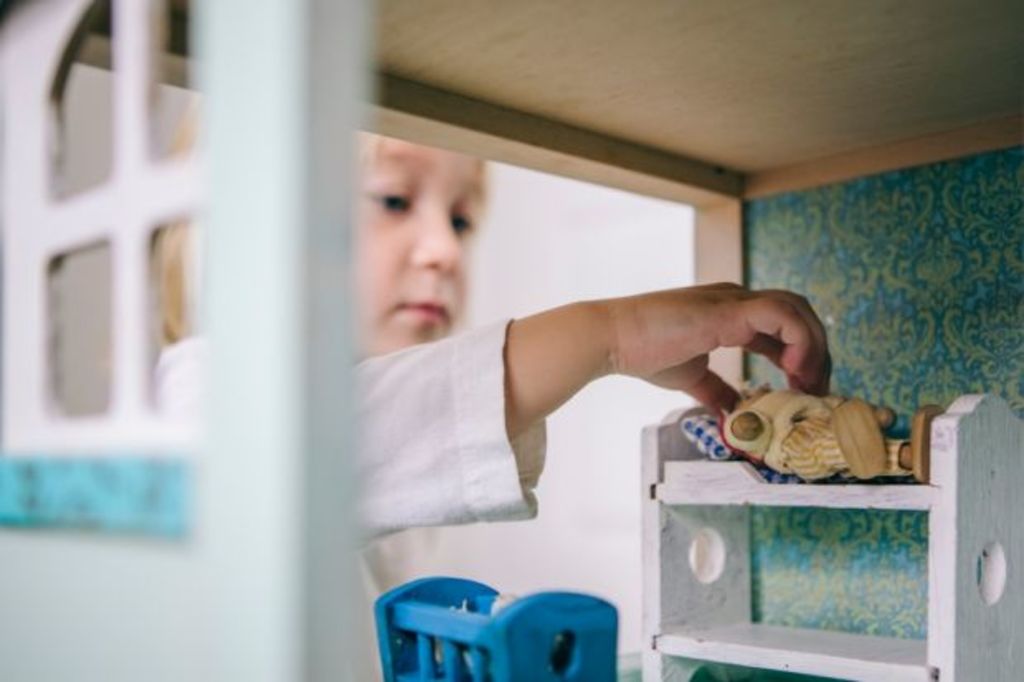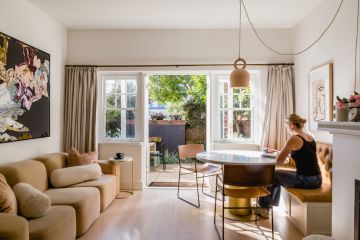When home staging takes the home out of home

On a recent Friday evening I pulled into the driveway of the weekend home here that my partner and I have shared for the past couple of years – and registered the first in a series of “Twilight Zone”-ish shocks. The car headlights swept the glass sliders of our modern house, illuminating a reconfiguration of the living room furniture so curious, I half-suspected slippage on the Ventura Fault.
I let myself in, flipped on some lights and discovered the room had been filled with enough white moth orchids to stock a Home Depot nursery. Our bookshelves, on the other hand, were largely denuded, save for the odd antler fragment or coffee mug. I made my way to our bedroom: more orchids, draped chenille throws, stacks of decorative pillows. It looked like a suite at the Marriott.
As disorienting (and puzzling) as any of the additions to the rooms were the deletions. The missing pieces included the sentimental (photographs), the collectible (a Nakashima table) and the indispensable (the dog bed).
Dee-dee, dee-dee; dee-dee, dee-dee. Submitted for your approval: You return to your home to discover it both is and isn’t your home, an eerie domestic experiment melding the familiar and the strange, because … your house has been staged!
A few weeks earlier, after realising we weren’t using the place as much as we had hoped to, we had listed it with a real estate agent in the area. It was at our second meeting with the agent that she gently raised the subject of having the house professionally zhooshed for sale. The agency routinely staged its properties, she told us, using the best stager in town. Staged houses (“decluttered and depersonalised”) sold faster. They brought in more money.
My first thought had been: I did my own zhooshing. I once spent an entire evening (a purposeful, chardonnay-fueled evening) finding the perfect spot in the house for a piece of pottery the size of a radish. I used to write for Architectural Digest! I was going to let a stranger pimp my home with vanilla-scented candles and coffee-table books anchored by magnifying glasses?
Then I had an idea. Even our minimally appointed house held a few extraneous items: My collection of vintage shelter magazines. My partner’s Browning 20-gauge shotgun (a gift on his ninth birthday from his father, used once). The small, expressionist sculptures our pug had created out of rawhide chews.
I spent a weekend boxing stuff and moving it to the garage.
After that, the rooms were as spare as haiku. A stager would have to conclude that the only expendable was herself.
Then I met the Stager. A stylish, compact blond woman, the Stager had the sphinx-like air of a clairvoyant or a customs officer. “What’s the room with all the books for?” she asked, peering into our library. She proceeded to share her “50 percent rule” for bookshelves: “More than 50 percent of shelf space devoted to books equals clutter.”
Rattled, I followed the Stager and our real estate agent into the bedroom. “We’ll freshen the bedding, remove the sofa and coffee table and repurpose the accessories,” the Stager said, eyeing a carved koa bowl I had picked up in Kauai, Hawaii. “Our goal is a coherent visual narrative.”
“What’s wrong with the bedding?” I asked, noticing a querulous tone creeping into my voice. Our sheets were Pratesi (a Christmas splurge).
She smiled patiently and shifted her gaze to the floor (carpeted, thankfully, in seagrass, the Switzerland of floor coverings).
“This is always hard on sellers,” our real estate agent said. “It’s all part of the letting-go process.”
If so, I thought, surely time would help. When, two weeks later, I drove back to Santa Barbara from our home in Los Angeles, I was confident I had begun to let go, eager to experience the coherent visual narrative the Stager had woven.
I’ll spare the reader the rant our unwitting real estate agent endured. (I sounded like Mrs. Howell on “Gilligan’s Island,” leaning on invective like “ghastly” and “appalling.”) Our real estate agent apologised copiously. She said she would talk to the Stager about destaging the house.
In the meantime, I decided to do a little homework on staging.
The first stager, at least by her own reckoning, was Barb Schwarz, a Seattle real estate agent who started sprucing up homes going to market in 1972. Her previous career in the theatre suggested a name for her new profession. “I’m the one who invented the word ‘stage’ to describe fixing up houses for sale,” Schwarz told me. “I have a federal trademark on it even though it’s broken all the time.”
Staging has grown exponentially over the years. According to a survey conducted by the National Association of Realtors last year, 34 per cent of sellers’ agents rely on staging to move all their homes. And that is just in this country.
“It’s changing real estate all over the world,” said Schwarz, who estimates she has personally taught staging fundamentals (“green in every room whether it’s a napkin or a plant”) to more than 1 million students, in places as far-flung as Malta and Japan.
There are staging Oscars: The annual Real Estate Staging Association awards in Las Vegas, honouring staging standouts in the United States, Canada, Australia, South Africa and the United Kingdom, has almost as many categories as the Academy Awards (Best Rising Star, Best Stager, Vacant Category, Canada).
Stagers range from graduates of two-day certificate courses whose stock in trade is room deodorisers, to fancy designers who do only high-end spec jobs. A developer-built house in Beverly Hills, California, was recently staged with Roberto Cavalli place settings, Yves Saint Laurent fire extinguishers and a replica of James Dean’s Triumph motorcycle. It was sold to Minecraft creator Markus Persson for $US 70 million ($A 91 million).
Staging today often means top to bottom transformations. “We really will fill out rooms to almost an Architectural Digest level,” said Meridith Baer, who is the Markus Persson of stagers (she has offices in seven cities and some 250 employees to help fluff homes for clients like Kanye West and Bob Dylan). “We try to make them aspirational, to show buyers what kind of lifestyle they can have in the home.”
The go-to look is spare, modern and as personality-free as a W Hotel suite or a Restoration Hardware catalogue layout. The New York Times real estate section recently documented Baer’s restyling of the New York apartment of Jean-Paul Beaujard, a well-known designer and antiques dealer; she swapped his ornate empire furniture and gleaming bare floors for clean-lined sofas and chairs and textured sisal rugs. The place sold in a month and a half.
I was starting to wonder if I had been hasty in my personal dismissal of staging. A statistic often cited by staging businesses began to interfere with my sleep: Staged homes fetch, on average, 17 per cent higher prices than unstaged homes. That figure is attributed to the US Department of Housing and Urban Development.
I decided to call HUD, just to double-check the number. “HUD has done no such research in the past 20 years,” said Jereon Brown, general deputy assistant secretary for public affairs. You heard it here first.
The effectiveness of staging was of enough interest to a team of researchers at the College of William and Mary, Johns Hopkins Universityand Old Dominion University that they conducted a study in which several hundred participants took virtual tours of staged and unstaged homes and were asked to estimate their worth. The subjects favoured the staged homes, but they didn’t attach a higher value to them.
I was intrigued by the psychology of staging as much as its value. How was it, anyway, that homebuyers had lost the ability to look past dog beds and family photos? “Life is just getting faster and faster, and people don’t have time or patience anymore,” Baer theorised. “They want to have everything spelled out for them.”
Certainly staging mirrors branding, the global trend toward marketing things less for what they are than for what they represent – usually a lifestyle. (See also: the Kardashians peddling ShoeDazzle.)
And if furnishings don’t adequately convey the lifestyle in question, one can employ human props. Showhomes, a staging company based in Nashville, Tennessee, hires “home managers” to stay in houses for sale and add that personal-but-not-too-personal touch – clothes in the closet (as long as they’re organised by colour), a car in the garage (provided the oil spots are removed).
But what does it say about us when we can no longer acquire a home without being shown how to live in it?
I consulted Marjorie Garber, the William R. Kenan Jr. professor of English and visual and environmental studies at Harvard University and the author of “Sex and Real Estate: Why We Love Houses,” a kind of polymathic valentine to (unstaged) homes. I assumed Garber and I would be on the same page, staging-wise.
“Your question seems to imply some kind of loss, whether of imagination, independence, will, or taste,” she wrote in an email. “For me it’s not something missing but something added. … Advertisers have done this for years, setting their clothing or perfume ads in exciting or provocative venues; it was the ambience rather than the product that sold. Why not houses? Certainly it’s more fun this way.”
Well, maybe so. For the buyer, anyway. For this seller, fun was hiring four labourers to help move the Stager’s things out of my home and my things back in. It was empowering. (Curiously, the destaging process took only three hours, compared with three days for staging. Don’t get me started on the cost disparity.)
The practical ramifications of reclaiming our house were another matter. But it turned out we needn’t have worried. We received an offer on the property, a decent one, within a month.
And that wasn’t even the most gratifying part. The first serious buyer to come along wanted to purchase the place furnished. With our things. We happily declined.
We recommend
We thought you might like
States
Capital Cities
Capital Cities - Rentals
Popular Areas
Allhomes
More







